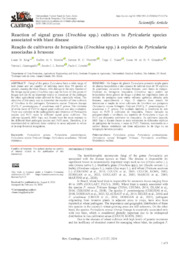Reaction of signal grass (Urochloa spp.) cultivars to Pyricularia species associated with blast disease.
Reaction of signal grass (Urochloa spp.) cultivars to Pyricularia species associated with blast disease.
Author(s): KRUG, L. D.; MOREIRA, S. de S.; VICENTINI, S. N. C.; NUNES, T. C.; GONÇALVES, L. M. de D. P.; CASTROAGUDIN, V. L.; BARRIOS, S. C. L.; CERESINI, P. C.
Summary: ABSTRACT - Fungi of the genus Pyricularia have a wide range of host plants and are capable of infecting more than 50 species of grasses, causing the blast disease, with damage to the ears. Species of the forage signal grass (Urochloa spp.) can be hosts of this genus of fungus and can be an important source of inoculum of the pathogen for other agricultural crops affected by blast, especially wheat. The objective of this study was to determine the reaction of nine cultivars of Urochloa to the pathogens Pyricularia oryzae Triticum lineage (PoTl), P. pennisetigena, P. urashimae, and P. grisea. The virulence of seven races of PoTl to signal grass cultivars was also evaluated. There was variation in the pathogenicity and virulence of Pyricularia species and PoTl races in different signal grass cultivars. The cultivars Ipyporã, BRS Tupi, and Xaraés were the most resistant to the different blast pathogen species and PoTl races. Therefore, it is recommended to cultivate these varieties in areas adjacent to wheat or in crop-livestock integration. RESUMO - Os fungos do gênero Pyricularia possuem ampla gama de plantas hospedeiras e são capazes de infectar mais de 50 espécies de gramíneas, causando a doença brusone, com danos às espigas. Espécies da forrageira braquiária (Urochloa spp.) podem ser hospedeiras deste gênero de fungo e podem ser importante fonte de inóculo do patógeno para outras culturas agrícolas afetadas pela brusone, especialmente o trigo. O objetivo deste estudo foi determinar a reação de nove cultivares de Urochloa aos patógenos Pyricularia oryzae linhagem Triticum (PoT1), P. pennisetigena, P. urashimae e P. grisea. Foi avaliado também a virulência de sete raças de PoT1 á cultivares de braquiária. Houve variação na patogenicidade e virulência das espécies de Pyricularia e raças de PoTl em diferentes cultivares de braquiária. As cultivares Ipyporã, BRS Tupi e Xaraés foram as mais resistentes às diferentes espécies de patógenos da brusone, e raças de PoTl. Portanto, recomenda-se o cultivo dessas variedades em áreas adjacentes às de trigo ou na integração lavoura-pecuária.
Publication year: 2024
Types of publication: Journal article
Unit: Embrapa Beef Cattle
Observation
Some of Embrapa's publications are published as ePub files. To read them, use or download one of the following free software options to your computer or mobile device. Android: Google Play Books; IOS: iBooks; Windows and Linux: Calibre.
Access other publications
Access the Agricultural Research Database (BDPA) to consult Embrapa's full library collection and records.
Visit Embrapa Bookstore to purchase books and other publications sold by Embrapa.

